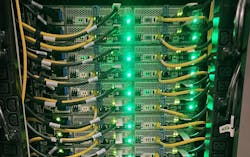Scorecard: Looking Back at Data Center Frontier’s 2023 Industry Predictions
It’s important to be accountable for your predictions and projections. At Data Center Frontier, we track our annual forecasts, and report back to our readers about how they turn out.
Last January, we identified Eight Trends That Will Shape the Data Center Industry in 2023. Some were on the money (generative AI, supply constraints, second-tier markets), while a couple were either off-base or slightly ahead of their time.
Here’s the scorecard for our 2023 forecast, including whether each prediction was a Hit, Miss or Too Early.
Watch for our “Eight Trends That Will Shape the Data Center Industry in 2024″ forecast.
1. Supply and Demand Meets Constraints and Delays
PREDICTION: After several years of powerful growth, the digital infrastructure sector faces a challenging environment for building new data centers at Internet speed. As a result, data center space will be harder to find and could cost more, particularly in the second half of 2023. On the supply side, key markets are facing power constraints, and new deployment timelines may be slowed by supply chain issues and community resistance.
HIT: Constraints and delays were indeed a big story in 2023, as supply chain issues and shortages of land and power resulted in longer data center development timelines. Data center development now takes 3 to 5 years or longer in primary markets, according to JLL. Already low vacancy rates have dropped to around 3 percent in primary markets, including 0.9% in Virginia, the largest cloud cluster.
2. Generative AI Tools Emerge as Game Changers
PREDICTION: Surging interest in generative AI will lead to fresh investment, even as users sort out the technology’s potential and problems. For the data center sector, this means more demand for specialized HPC platforms. The large cloud providers will be key players here, but forward-leaning enterprises may want to use these tools to unlock business value in proprietary datasets that may not be cloud candidates.
HIT: It’s hard to overstate how AI is driving demand for new technology and server space. “AI is having a profound impact on the data center industry,” writes datacenterHawk. “This surge in investment has led to an increasing demand for data center power and space, driven by AI applications.” This trend is showing up in this year’s outsized leasing – including a 430-megawatt pre-lease in Loudoun County – as developers supersize their campuses.
3. The Data Center Industry Confronts its PR Problems
PREDICTION: There's a growing narrative that data centers are bad neighbors and devour vital community resources like water and electricity. As the negative headlines piled up, resistance to data centers expanded into growth markets with no history of previous data center development. In these cases, residents are seeking to reject new cloud infrastructure projects based on media reports about controversies in other regions. This could become a significant business problem for data center builders as major markets face constraints on the availability of land and utility power.
HIT: We’ve seen resistance to data center developments become much more visible in 2023, prompting data center developers to create executive positions for community engagement. Critical media coverage has migrated from local newspapers to national publications like The Washington Post, Axios and Business Insider. In Virginia, a group of 27 environmental and conservation groups formed the Virginia Data Center Reform Coalition to call for regulation of data center growth.
In response, the Data Center Coalition worked to help the industry tell a more complete story through efforts like the Center of Your Digital World web site, which summarizes the benefits of data centers for the Internet and local communities.
4. Going Waterless, Everywhere You Can
PREDICTION: One of the major tensions in data center development is the large amount of water used to cool some data centers. Extreme heat and drought are raising the bar for fast-growing cloud computing platforms and data center developers. … The energy efficiency revolution was a response to public pressure and fears of regulation. Expect to see a similar wave of innovation in addressing water conservation in coming years, starting in 2023.
HIT: I’d love to have seen more widespread innovation in water conservation. But in 2023, providers in water-stressed markets like Phoenix deployed fresh air cooling, air-cooled chillers and closed loop cooling systems that dramatically reduce the volume of water used. On the hyperscale front, we had public pronouncements from Google on being climate-conscious and assessing watershed health in regions where it builds data centers. Meanwhile, Amazon Web Services shared details on its growing use of recycled water in its cloud hubs in Virginia and Santa Clara.
That said, there’s growing concern about how AI compute loads might impact data center water usage, and the growth of cloud operations is actually translating into more water use by hyperscale operators like Microsoft, which saw its water usage rise 34% from 2021 to 2022. Although many data centers are prioritizing existing strategies for lower water impact, much work remains.
5. For Hungry Hyperscalers, it's a Year to Digest
PREDICTION: Anyone who has tracked data center activity over the past year shouldn't be surprised to learn that hyperscale operators may lease less space in 2023. These companies took down historic amounts of data center capacity in the first half of 2022, accelerating their infrastructure expansion amid concerns that the delivery of future capacity would be slowed by supply chain disruptions. … It was inevitable that at some point leasing would slow as these companies digest the capacity they've already provisioned.
MISS: Wow, did we miss the mark here. Instead of slowing, we saw a leasing spree led by hyperscale operators seeking data center space to house power-hungry server hardware for new generative AI applications.
By mid-year, analysts were highlighting a “tsunami of AI demand”, exceeding pandemic-era records for leasing activity. JLL cited a “a significant surge in leasing in the second quarter of 2023, with a mounting demand for capacity to meet higher density data center requirements for AI development.”
6. Secondary Markets Continue to Boom, from Cloud to Edge
PREDICTION: This year we are doubling down on our emphasis on data center growth in secondary markets, a trend that has gained momentum as power shortages have emerged in primary markets. This will include the emergence of more submarkets around existing data center corridors, as well as massive projects in new areas with enough power and land needed to support the new breed of MegaCampuses.
HIT: The continuing growth in secondary markets was highlighted by the data center building boom in Atlanta, which become a focal point for cloud development after years of being viewed as a regional market. Atlanta had the highest absorption nationally in 3Q 2023, according to datacenterHawk, while markets like Reno, Salt Lake City, Boydton in Virginia and Oregon’s Umatilla benefitted from hyperscale growth.
“Many markets are acutely feeling the strain of demand and its impact on power transmission infrastructure and overall power supply,” said datacenterHawk. “This is driving demand into new submarkets of established areas and giving completely new markets an opportunity to attract large-scale data center development.”
7. More Data Centers Embrace On-Site Power Generation
PREDICTION: In 2023, we will see more data center projects that include on-site energy generation to enable expansion in grid-constrained markets. … We're also likely to see more focus on the use of hydrogen fuel cells for both backup and primary power. We can expect to see an accelerated focus on this technology in 2023.
TOO EARLY: I believe this prediction is directionally correct, but we said, “in 2023” and thus far there have been a limited number of new developments. These include deployments of natural gas generation by AWS in Oregon and Microsoft in Dublin to support multi-facility campuses.
On the long-term planning front, prospective data center projects in Virginia and West Virginia have expressed interest in operating small modular reactors (SMRs) to provide nuclear power for data centers. As power constraints continue in key markets, interest in on-site power may ramp up.
8. Rethinking Churn: A Problem Becomes an Opportunity
PREDICTION: Data center providers have always seen churn as the enemy. But attitudes toward churn, in which tenants vacate data center space when their lease expires, have been evolving as the industry enters a period of capacity constraints. When a customer departs, providers must fill the empty space, which doesn't generate revenue while it is vacant. In an environment where new capacity is scarce, existing space becomes more valuable.
HIT: Although we don’t have a breakout of pre-used space, the pricing trends were higher across product types in the industry as operators benefited from limited supply in many markets. Although rates fluctuated in different geographies, prices rose about 15% year-over-year, according to datacenterHawk.
Other analysts reported larger price hikes. “Primary markets have a limited inventory of colocation space, leading operators to increase pricing by 20–30% year-over-year,” said JLL.
The Scorecard
So here’s a look at the final score for 2021. We wound up with 6 Hits, one Miss, and one prediction that we classify as Too Early.
For comparison, here’s our track record for previous years:
2018 Scorecard: We had five Hits, one Miss and two predictions that qualify as “Too Early.”
2019 Scorecard: Six Hits, one Miss and one “Too Early” score.
2020 Scorecard: Once again, the final tally was six Hits, one Miss and one “Too Early.”
2021 Scorecard: Six hits, one Miss and one “Too Early.”
2022 Scorecard: We had six Hits, one Miss and one prediction that was Too Early.
Watch for our “Eight Trends That Will Shape the Data Center Industry in 2024” forecast. You can also receive updates so you don’t miss our analysis.
About the Author


